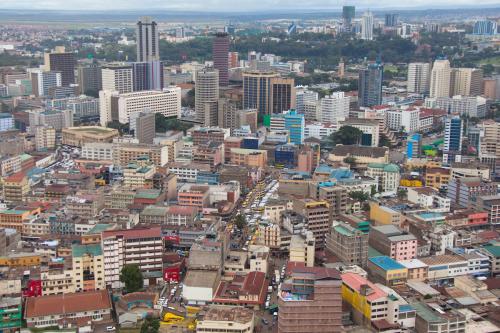This report is part of a series of essays by the Global Economy and Development program—a 10th anniversary edition. The series, available here, delves into the critical issues facing all those concerned about globalization. You can join the conversation on Twitter using #11GlobalDebates.
1.1 what’s the issue?
Nine years ago the global urban population surpassed the world’s rural population, making it clear that the fate of cities will determine our future prosperity. As enshrined in the United Nations’ Sustainable Development Goals, for cities to thrive, action is needed to ensure that urban areas and human settlements are “inclusive, safe, resilient, and sustainable.” With the October 2016 U.N. Conference on Sustainable Housing and Urban Development (Habitat III) in Quito, Ecuador set to agree on a new global urbanization agenda for the next two decades, the time to advocate for inclusive, accessible cities is now. Achieving better physical accessibility of all households to employment, services, and commerce within cities is essential.
881 million was the total population of slum dwellers around the world in 2014.
One obstacle to inclusive cities is rising income inequality. The U.N. estimates that, in the developing world, inequality has increased by 11 percent from 1990 to 2010, with 75 percent of the population now living in societies “where income is more unequally distributed than it was in the 1990s.”
In Africa, almost 62 percent of the urban population lives in slums. Higher-income country cities are also facing increasing income inequality, whether in Boston, London, or Madrid.
Spatial distribution in cities due to income disparities merits closer scrutiny. Whether it is the spread of informal settlements around Lima or Mexico City or the “suburbanization” of poverty in U.S. cities, studies confirm the prevalence of spatial segregation by income (Kneebone and Berube 2013). This pattern has exacerbated the issue of access; left unchecked, it could further deepen inequality and poverty.
28%—the rate at which the number of urban residents living in slums has increased over the past 14 years.
A first step toward inclusive access is to better understand where people choose to live as well as what determines the location of jobs, commerce, and services (Angel and Blei 2015). What are the trends and patterns for low-income households and their physical access? Does our idyllic view of the sustainable, compact city with investment in key transport infrastructure as the backbone of revived central business districts serve the access needs of low-income households? Does our standard menu of land use and transport policies, regulations, and investment ensure an adequate level of inclusivity?
1.2 What’s the debate?
While the diverse stakeholders involved in solving city problems agree on the importance of access to ensuring inclusive urban development, they tend to address the issue from within professional silos. A common narrative around which to frame the objective of access, along with integrated policies and investment interventions to foster that goal is needed. That common narrative remains a source of debate.
1.2.1 What is accessibility?
Accessibility is the number of opportunities such as jobs, schools, and commerce, one can reach within a given time and cost. The most recognized measure is the number of employment opportunities that are available within reasonable commuting distances of a specific household or neighborhood. A standard measure of access has not been applied in practice very broadly because of daunting data requirements. Calculating this measure for lower-income populations requires household information as well as details on the type and number of relevant job opportunities. Information technology and meta-data software are beginning to ease these measurement challenges.
One can enhance access in two ways. First, by providing transport services and/or infrastructure to ease travel between households and opportunities by speeding commuting times and reducing congestion. Second is by facilitating the construction of housing closer to such opportunities or by relocating employment, services, and commerce–the land use option. Thus, understanding the interaction of land use and transport and the dynamics over time of location decisions help determine optimal measures to facilitate access.
1.2.2 What are the implications for land use and transport policies?
Efforts to facilitate housing and land use location for low-income households are legion. The need to remove discriminatory practices such as exclusionary zoning, limited floor area ratios, or restrictive financing practices is well understood. Planners must also grapple with legitimate market forces that result in spatial segregation. The suburbanization of poverty in places such as the U.S. or the growth of informal settlements or slums along the periphery of Buenos Aires is the result of land market signals. Yet even as we laud the growth and renewal of city centers, experts are unable to stem the resulting gentrification.
Countries and cities have tried to counter this effect through social housing policies such as requiring the reserve of units for low and/or moderate income households in residential developments or by building subsidized housing. The jury is still out on the scale and sustainability of such practices. Do mixed-income neighborhoods offer the range of services required by different income households? And do such mixed-income communities offer an equivalent measure of access, including sufficient job opportunities, for all income levels?
For the urban transport sector, the emphasis on accessibility requires a departure from the traditional approach to investment planning, with implications for service and pricing policies as well as investment. Unlike household access measures for electricity, telecommunications and water, there is no equivalent metric for urban transport. Measuring whether the household is within walking distance of a metro or bus stop does not reveal much without knowing whether that service actually connects the household to needed locations at an affordable price.
Sectoral planning and economic evaluation methods are more directed at improving mobility, speeding commuting time, and reducing traffic congestion. Mobility alone is insufficient to enhance accessibility and is ineffective in repairing inequities faced by low-income households. When accessibility measures are applied, they are mainly used to determine impacts of selected investments rather than to judge between alternative investments designed to improve access.
1.3 What to watch out for?
Whether it is the selection of new construction investments, the structuring of capital finance, funding for a bus system, or the cost recovery and pricing practices of public agencies, enhancing access requires a comprehensive understanding of how transportation finance is handled at all levels of government. Boosting accessibility will force difficult spending decisions, like whether to build affordable housing in one place or to provide discounted transportation service in another. The massive infrastructure capital investment required for urban areas is stretching the limits of fiscal budgets. A turn to private capital and the promotion of public-private partnerships could help, but such a shift will place an onus on governments to ensure that investments will foster inclusive access. Assigning risks and responsibilities between the public and private sector will be critical. Governance is a vital part of the accessibility agenda. Urban governance emerges from the interplay between the values of a society and the expertise and interests of public and private actors.
Achieving good urban governance requires finding the right balance between often competing objectives, technical requirements, and interests, while at the same time overcoming coordination problems within and between dispersed public and private actors. Strategic governance for achieving accessibility requires coordinated actions across urban land use (e.g., housing policy), transportation planning and regulation, financing of investment and operations, and pricing and cost recovery. This is difficult within a single municipal jurisdiction across sectors and institutions. But it becomes even more complex when coordinating across municipal boundaries to connect infrastructure and service networks, agree on management of land use, and settle on sources of financing.
1.4 What’s next?
First, it will be important to build a common narrative that captures the interests and commitments of the various professional and academic networks as well as the range of stakeholders to ensure they understand and pursue the accessibility agenda. It is necessary to incorporate the approach as well as agreed measurement strategies into key decisionmaking processes and to assess the results.
Second, though measuring accessibility is not easy and requires extensive data inputs, new approaches and information technology are making it easier to compile and analyze across a range of cities. Nonetheless, more empirical research is needed to validate such measures and better understand the interactions of land use, transport, and individual as well as corporate decisionmaking.
We should continuously question how new technology can be harnessed to promote accessibility and explore the effects of innovative approaches such as ride sharing services or autonomous vehicles. As new technology, research, and ideas arise, the world’s cities will keep changing. So should our plans for keeping cities inclusive.
Finally, we must recognize that enhancing access is context specific. What may be appropriate for Sao Paolo may not be appropriate for Hanoi; what may be feasible in Portland, Oregon, may work in Addis; or what is acceptable in Copenhagen may not be desirable for Mumbai. There is no cookie-cutter approach, and there is much learning and adapting required at this critical juncture in the evolution of urbanization.






